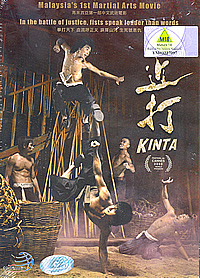SYNOPSIS:
In the 1980’s, Chinese immigrants flooded Kinta Valley when tin ore was discovered in the area. Master Hoong consolidates his domination of the Southern Ocean by teaming up with a mysterious secret society to suppress struggling miners.
A group of the miners including Dragon, Tiger, Ace and Blaze unite under the leadership of Tin Sok to take on their oppressors. In the fight of justice and survival of the fittest, a heroic battle of earth shaking proportions ensues.
MOVIE REVIEW:
Somewhere within this hulk of a mess lies a film with great potential- unfortunately, getting there is about as tedious as mining tin, the subject of which is at the heart of “Kinta”. In perhaps one of the most laborious prologues on film, “Kinta” introduces its audience to the plight of tin miners- poor Chinese immigrants drawn by the prospect of jobs to the tin ore-rich Kinta Valley, and hence the name of the movie.
For the sake of profit, the head of the tin mine, Master Hoong (Patrick Teoh) sends his henchmen to execute every last one of them. Four manage to escape, their not-so creative names- Dragon, Tiger, Ace and Blaze. Rescued by a local Malay villager and nursed back to health, they return to the lion’s den to participate in an inaugural fighting competition set to determine the new head of the mine.
It’s not necessary for martial arts films to have a particularly complex story- indeed, most usually just do fine with the usual setup of good guys, bad guys and that final climactic battle where good triumphs over evil. So “Kinta’s” simple, even simplistic, and straightforward story really isn’t its handicap. Instead, what turns this into one dull, dreary and utterly monotonous affair is how first-time feature director C.L. Hor tells his story.
It’s obvious “Kinta” is struggling to find its own voice when in between that self-serious prologue is the opening credits done manga style, complete with an indecipherable English rap song that keeps going “fight, you gotta fight”. That schizophrenia gets even worse when the action begins. For some unfathomable reason, director C.L. Hor chooses to CGI copious amounts of fake blood on-screen everytime someone gets slashed, punched or kicked, turning this into the equivalent of a live-action anime.
Were this the intention of the filmmakers, such stylistic touches would have been more acceptable. But no, from the tone of the rest of the film, it’s clear “Kinta” was meant to be one of those classic Hong Kong martial arts flicks a la “Wong Fei Hung”. How else will you explain why “Kinta” spends more than half its time describing the miserable plight of the oppressed by a stronger, fiercer enemy whom they eventually, by their sheer grit and determination, manage to defeat?
Perhaps the only saving grace has going for it is its fresh, young cast. Wooden and quite inexpressive though they may be, where required to deliver some necessary stunt appeal, you can be sure these local wushu champions can competently give you a chop-socky good time. Otherwise, there’s nothing to shout about the fight choreography by Hong Kong’s Chin Kar Lok- not even the finale is something you haven’t seen before.
If there already are a litany of gripes about “Kinta”, let me just add one more. Again, for some inexplicable reason, “Kinta” thinks its audience may be suffering from short-term amnesia and hence its need to replay certain pivotal scenes over again in their entirety. It’s an understatement to describe how annoying this actually is. Classic this movie certainly is not, Malaysia’s first martial arts movie has a long way to go before it becomes anything more than a junk heap of scrap.
SPECIAL FEATURES :
This Code 3 DVD contains no extra features.
AUDIO/VISUAL:
Audio is presented only in Dolby 2.0 and turns out surprisingly dull for a film of this nature. Visuals are good enough, with visible grains only spotted in a minimal number of scenes.
MOVIE RATING:
 
DVD
RATING :

Review
by Gabriel Chong
Posted on 18 September 2009 |

